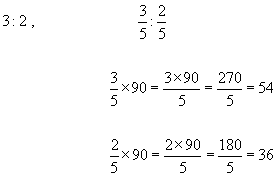a what is the ratio of the number of

Ratios and proportions – two terms that may sound complicated, but at their core, they are just ways to compare numbers. So why not join me on this mathematical journey and explore the beauty of ratios and proportions?
Ratio & Proportion
Let’s start with the basics. A ratio is a comparison of two or more numbers, usually written in the form of a fraction. For example, if we have four red apples and six green apples, the ratio of red to green apples is 4:6, which can be simplified to 2:3.
Proportions, on the other hand, are just a special kind of ratio. They express a relationship between two ratios that are equal in value. If we have two ratios, such as 2:3 and 4:6, we can set up a proportion to see if they are equal:
2:3 = 4:6
By cross-multiplying (multiplying the numerator of one ratio by the denominator of the other, and vice versa), we get:
2 × 6 = 3 × 4
12 = 12
Since the equation is true, the two ratios are proportional. Proportions may seem abstract at first, but they are used in everyday life, from cooking and baking to scaling maps and building structures.
Sharing in a Ratio
Now that we have a better understanding of ratios and proportions, let’s explore how to share a quantity in a given ratio. This is where the fun begins!
Let’s say we have a bag of marbles with blue, red, and yellow marbles. The ratios of the colors are 2:3:1, respectively. How many of each color marble do we have if there are a total of 120 marbles in the bag?
To solve the problem, we start by finding the total number of parts in the ratio:
2 + 3 + 1 = 6
We can then divide the total number of marbles by the total number of parts to find the value of each part:
120 ÷ 6 = 20
So each part of the ratio is equal to 20 marbles. To find the number of marbles for each color, we simply multiply the corresponding ratio part by 20:
Blue marbles: 2 × 20 = 40 marbles
Red marbles: 3 × 20 = 60 marbles
Yellow marbles: 1 × 20 = 20 marbles
And there you have it – 40 blue marbles, 60 red marbles, and 20 yellow marbles!
The Golden Ratio
Moving on from sharing marbles, let’s explore a fascinating aspect of mathematics that is present in nature and art – the Golden Ratio. The Golden Ratio (also known as the Divine Proportion) is a special number approximately equal to 1.61803398875. It has been used since ancient times in architecture, design, and art as a guideline for creating aesthetically pleasing compositions.
The Golden Ratio is found by dividing a line into two parts, so that the longer part divided by the smaller part is equal to the whole length divided by the longer part. This can be expressed mathematically as:
(a + b) / a = a / b
This might seem like a simple equation, but it has some incredible properties. For example, if you take a rectangle that follows the Golden Ratio and cut a square off one end, the remaining rectangle will still follow the Golden Ratio.
The Golden Ratio can also be found in the natural world. For example, the spiral pattern of shells and pinecones follows the proportion of the Golden Ratio. In fact, this spiral pattern is called a logarithmic spiral, which has a special relationship to the Golden Ratio.

But what about the use of the Golden Ratio in art? Well, it turns out that many famous artworks, including Leonardo da Vinci’s Vitruvian Man and Salvador Dali’s The Sacrament of the Last Supper, use the Golden Ratio as a guiding principle for composition and balance.

Conclusion
Ratios and proportions may seem dry and uninteresting at first, but we’ve seen that they can be used in everyday life, from sharing marbles to measuring ingredients in a recipe, to creating beautiful works of art. Meanwhile, the Golden Ratio, with its relationship to art, nature, and mathematics, shows just how interconnected and fascinating our world can be. So let’s embrace the beauty of math and explore the world through ratios and proportions!

Source image : www.mathswithmum.com

Source image : www.gcsemathstutor.com

Source image : www.askqotd.com






